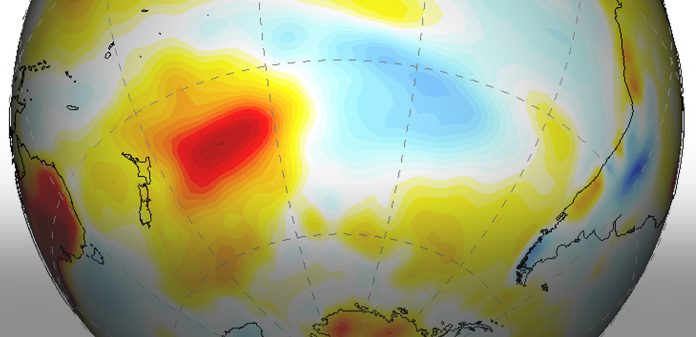RIO DE JANEIRO, BRAZIL – The Southern Blob, a large patch of warm water in the southwest Pacific, is responsible for much of the decades-long drought in much of Argentina, particularly Patagonia and Chile. The climate change impacts behind this situation are here to stay.
The surface waters of the South Pacific, east of New Zealand, show a very significant area of above-average temperatures, i.e., hot anomalies. According to the Sydney Morning Herald, this area is similar in size to Australia at about 8 million square kilometers.
This large warm water area, which meteorologists call the “Southern Blob,” is one of the reasons for the severe drought affecting parts of Argentina and Chile.

This situation could explain the megadrought that has affected some areas, such as northern Patagonia, on both sides of the Andes for more than a decade.
According to a study published in the Journal of Climate of the American Meteorological Society, sea level pressure has decreased over the Amundsen-Bellingshausen Sea (ABS) over the past four decades and increased between 30° and 40°S from New Zealand to Chile, forming a pressure trend dipole over the South Pacific.
The trends are strongest during the Australian winter and have affected the climate of West Antarctica and South America. The pressure trends, in turn, have been attributed to decadal variability in the tropics and the expansion of the Hadley cell.
In the research summary, the group led by Rene Garreaud, Kyle Clem, and Vicencio Veloso explain that these mechanisms account for only about half of the intensity of the pressure trend dipole.
Experiments with two atmospheric models suggest that upper-ocean warming over the subtropical Southwest Pacific (SSWP), the so-called Southern Blob, explains about half of the negative pressure trend in the ABS region and almost all of the wedge/drought over the eastern subtropical South Pacific, contributing to the mega sequence in central Chile and Argentina.
Multidecadal periods of strong SSWP warming also occur in fully coupled pre-industrial simulations associated with a pressure trend dipole and reduced precipitation over the central tropical Pacific, suggesting a natural origin of the Southern Blob and its teleconnection. However, the current rate of warming exceeds the range of natural variability, suggesting an additional anthropogenic contribution.
Researchers from Victoria University of Wellington, the University of Chile, and the Chilean Meteorological Service believe it is caused by recent climate change and found that it has a significant impact on the Southern Hemisphere’s climate.
Specifically, the research shows that intense warming in the South Pacific has shifted storm systems toward Antarctica and away from the west coast of South America, resulting in an uninterrupted succession of drought years in central Chile and adjacent areas of the Andes and Argentina. Because of its unprecedented longevity, researchers have dubbed it the “Central Chile Megasequence.”
A REALITY THAT WILL LAST
“Nobody was really prepared for such a bad decade, and the impact on natural vegetation, agriculture, hydropower generation, and drinking water supplies in rural areas is obvious,” Professor Garreaud of the University of Chile told Australian media.
Another important point he made was that up to half of the severity of the drought could be attributed to climate change, contradicting earlier assessments that the occurrence of the huge warm patch was entirely a natural event.
His words should be heeded by the governments of both countries. “In my opinion, the natural variability will mitigate the drought in the next decade, but the anthropogenic part will still be with us, so we will not return to the ‘old normal,'” he said. “In the long term, we are moving toward a drier – and warmer – condition compared to the recent past.
In short, beyond natural variations, this prolonged drought could be a permanent scenario for these researchers, as the warming of South Pacific waters is caused by the anthropogenic component of overall climate change.
Dr. Clem, quoted in a Victoria University report, says the world’s oceans have absorbed about 90 percent of the heat the Earth has gained from increases in greenhouse gases.
Sea surface temperature (SST) has increased by about 0.5 °C on average globally over the past 40 years (1979-2018), but it is not evenly distributed across the oceans. This area of Pacific surface temperatures has warmed about three times faster than the global average during the May-September winter season, by 1.5 °C over the same period.
It extends to a depth of about 100 meters. Although it covers only about one percent of the world’s ocean surface, “a recent study suggests that “The Blob” is responsible for up to a quarter of the ocean’s total heat uptake in recent decades,” Clem says.

